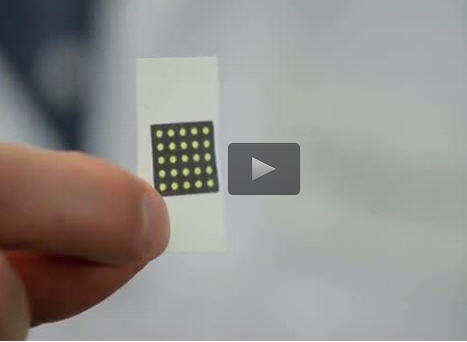Rapid, low-cost detection of Zika virus using paper-based synthetic gene networks

University of Toronto Assistant Professor of Pharmacy Keith Pardee and an international team of collaborators, including scientists from the Wyss Institute at Harvard University, have developed a low-cost, easy-to-use diagnostic platform for detecting the Zika virus. Credit: University of Toronto and Wyss Institute at Harvard University
Using cutting-edge technologies, the team of collaborators from Wyss, Massachusetts Institute of Technology, Boston University, Arizona State University, Cornell University, University of Wisconsin-Madison, Broad Institute, and the University of Toronto have developed a cell-free, paper-based platform that can host synthetic gene networks for use outside of the lab.
Employing toehold sensors and isothermal RNA amplification, the team has created diagnostic sensors on a freeze-dried piece of paper the size of a stamp. Activated by the amplified sample, the diagnostic sensors programmed into this paper provide extremely sensitive, low-cost, programmable diagnostics that provide rapid results.
This revolutionary paper-based sensor system provides a much needed solution to the challenge of diagnosing the Zika virus. Currently, reliable diagnosis for patients suspected of the Zika virus involves nucleic acid-based testing, which is dependent on laboratory access, highly specific and expensive equipment, and trained technicians. As a result, this type of testing is unsuitable and unavailable in remote locations where surveillance and containment are critically needed.
This new technology, on the other hand, is easy to use and requires little to no training. Specifically tuned to the Zika virus, sensors are applied to small paper samples. Using a small saliva, urine, or blood sample, equivalent to the amount required by blood glucose monitors to test blood sugar levels, the sample is applied to the sensors, triggering a response that provides visually evident results in as little as an hour.
If the sample contains the RNA of the Zika virus, the test area turns purple. In making such a simple to use test, the team has created a exciting tool that promises to bring portable, reliable, and inexpensive Zika diagnostics to the field at less than a dollar per test. Moreover, it does not require a lab, expensive equipment, or highly-trained technicians to administer.
“The diagnostic platform developed by our team has provided a high-performing, low-cost tool that can work in remote locations,” notes Dr. Keith Pardee, the lead author of the study. “We have developed a workflow that combines molecular tools to provide diagnostics that can be read out on a piece of paper no larger than a postage stamp. We hope that through this work, we have created the template for a tool that can make a positive impact on public health across the globe.”
“Our synthetic biology pipeline for rapid sensor design and prototyping has tremendous potential for application for the Zika virus and other public health threats, enabling us to rapidly develop new diagnostics when and where they are needed most.”
While this study in Cell demonstrates proof-of-concept, the team is eager to secure the necessary partners and resources to proceed to the product development phase, followed up by scaled up manufacturing and distribution so that the diagnostic tool can be deployed for use in the field.
Ultimately, the development of quick, easy-to-use, in-the-field tests for Zika and similar pathogens could help governments stay ahead of pathogen outbreaks, curbing the spread of disease and lessening the burden on already overtaxed healthcare systems.
###
To connect with Prof. Pardee, please contact:
Noreen Ahmed-Ullah
University of Toronto Media Relations
416-978-0100
media.relations@utoronto.ca
For further information, please contact:
Kat McAlpine
Wyss Institute Media Relations
katherine.mcalpine@wyss.harvard.edu
Media Contact
All latest news from the category: Health and Medicine
This subject area encompasses research and studies in the field of human medicine.
Among the wide-ranging list of topics covered here are anesthesiology, anatomy, surgery, human genetics, hygiene and environmental medicine, internal medicine, neurology, pharmacology, physiology, urology and dental medicine.
Newest articles

Making diamonds at ambient pressure
Scientists develop novel liquid metal alloy system to synthesize diamond under moderate conditions. Did you know that 99% of synthetic diamonds are currently produced using high-pressure and high-temperature (HPHT) methods?[2]…

Eruption of mega-magnetic star lights up nearby galaxy
Thanks to ESA satellites, an international team including UNIGE researchers has detected a giant eruption coming from a magnetar, an extremely magnetic neutron star. While ESA’s satellite INTEGRAL was observing…

Solving the riddle of the sphingolipids in coronary artery disease
Weill Cornell Medicine investigators have uncovered a way to unleash in blood vessels the protective effects of a type of fat-related molecule known as a sphingolipid, suggesting a promising new…





















